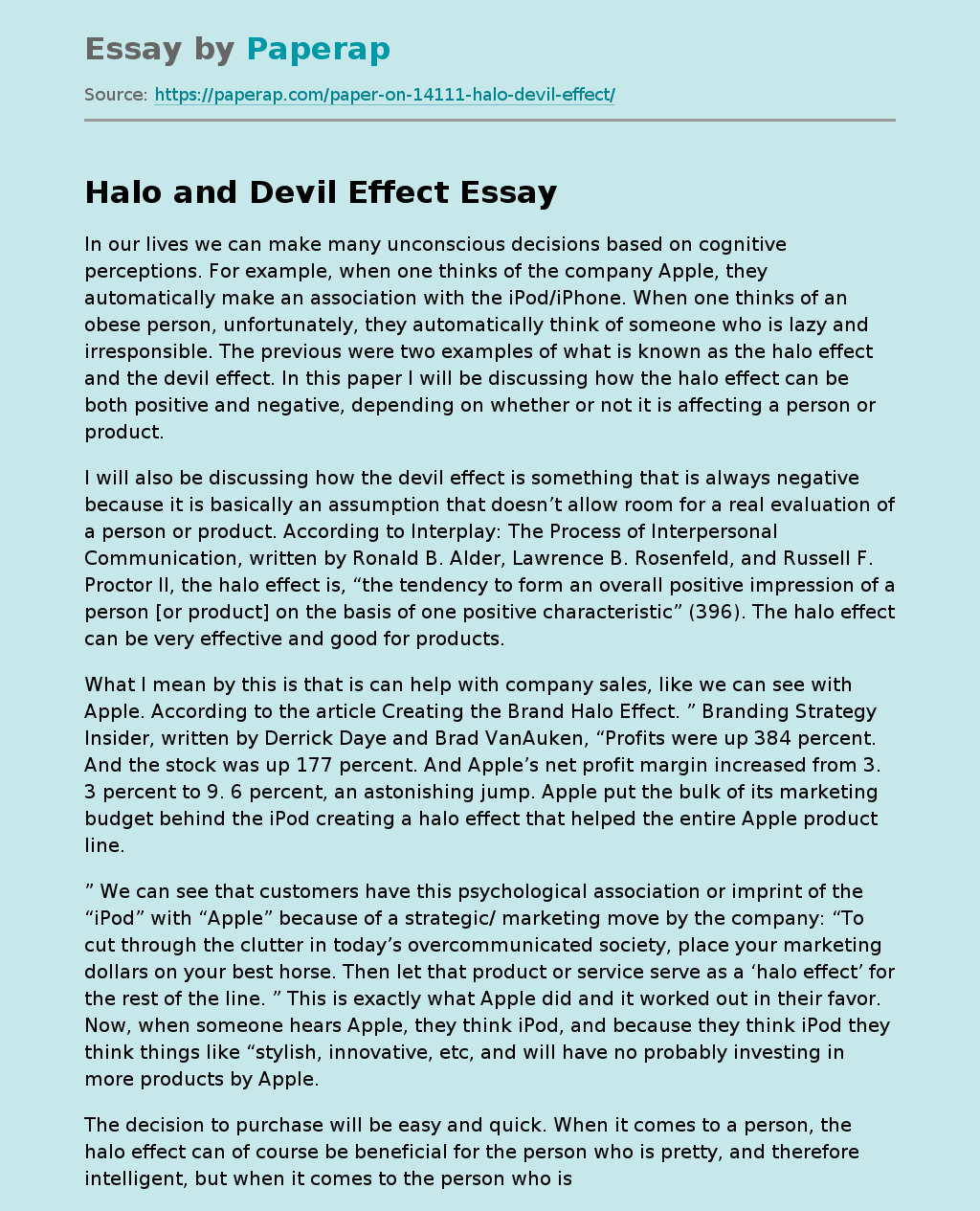Halo and Devil Effect
In our lives we can make many unconscious decisions based on cognitive perceptions. For example, when one thinks of the company Apple, they automatically make an association with the iPod/iPhone. When one thinks of an obese person, unfortunately, they automatically think of someone who is lazy and irresponsible. The previous were two examples of what is known as the halo effect and the devil effect. In this paper I will be discussing how the halo effect can be both positive and negative, depending on whether or not it is affecting a person or product.
I will also be discussing how the devil effect is something that is always negative because it is basically an assumption that doesn’t allow room for a real evaluation of a person or product. According to Interplay: The Process of Interpersonal Communication, written by Ronald B. Alder, Lawrence B. Rosenfeld, and Russell F. Proctor II, the halo effect is, “the tendency to form an overall positive impression of a person [or product] on the basis of one positive characteristic” (396).
The halo effect can be very effective and good for products.
What I mean by this is that is can help with company sales, like we can see with Apple. According to the article Creating the Brand Halo Effect. ” Branding Strategy Insider, written by Derrick Daye and Brad VanAuken, “Profits were up 384 percent. And the stock was up 177 percent. And Apple’s net profit margin increased from 3. 3 percent to 9. 6 percent, an astonishing jump. Apple put the bulk of its marketing budget behind the iPod creating a halo effect that helped the entire Apple product line.
” We can see that customers have this psychological association or imprint of the “iPod” with “Apple” because of a strategic/ marketing move by the company: “To cut through the clutter in today’s overcommunicated society, place your marketing dollars on your best horse. Then let that product or service serve as a ‘halo effect’ for the rest of the line. ” This is exactly what Apple did and it worked out in their favor. Now, when someone hears Apple, they think iPod, and because they think iPod they think things like “stylish, innovative, etc, and will have no probably investing in more products by Apple.
The decision to purchase will be easy and quick. When it comes to a person, the halo effect can of course be beneficial for the person who is pretty, and therefore intelligent, but when it comes to the person who is overweight and therefore lazy, it can pose an issue. This would be the devil effect. The devil effect, or the reverse halo effect, is the tendency to form an overall positive impression of a person/product on the basis of one negative characteristic or trait.
According to the article, Physical Attractiveness Bias in Hiring: What is Beautiful is Good, written by Comila Shahani-Denning, “There is considerable empirical evidence that physical attractiveness impacts employment decision making, with the result that the more attractive individual, the greater the likelihood that that person will be hired. This is generalization is known as the ‘what is beautiful is good’ stereotype” (14). What we can see from this quote is basically that if a beautiful woman comes in to interview for a managers position she will most likely be hired versus, lets say, an obese woman.
Based solely on looks, and not on qualifications, the hirer will have already assumed that because this woman is beautiful she must also be intelligent (halo effect). And because the other woman is obese she just has to be lazy and irresponsible. This is an example of the devil effect. The hirer will probably ask themselves something along the lines of “if this person cannot manage her own weight how will she manage this office? ” It is yet unfortunate, that often many decisions in the business world can be made based on that one negative or undesirable trait in a person.
The decision not to hire her because she isn’t skinny and pretty is biased and unfair. “Making hiring decisions based on non-job-related factors is detrimental to the overall organizational performance” (Shahani-Denning, 14). She may actually be more qualified for the position, and have a more impressive resume and job experience, versus the “beautiful” woman. When I think about how the halo and devil effect relate to today’s culture/popular culture, I think of the police department and how people get profiled on the street.
There is a lot of controversy going on that police profile based too much on looks and not enough on behaviors. For example, there are often times when I am walking down the street or about to take the train and I will see the police stopping a young kid who is dressed baggy. I believe they assume based on his baggy attire that he cannot be anything more than a “thug/dealer” or delinquent kid cutting school. They may be stopping this kid while someone walking right past them, who might actually look like your average Joe, could actually be the “thug/dealer.
” This would be the devil effect. But, because this average Joe is more attractive in the sense that he isn’t wearing his pants low, he will be overlooked or looked up upon by the police versus the rest of society as someone “good. ” This would be the halo effect. Overall, the halo and devil effect are very interesting. I believe these effects impact that world unconsciously every single day. We can look to many products, such as Apple products, and many people, like those involved in hiring processes to fully understand how both can play out in todays society.
Halo and Devil Effect. (2018, Feb 08). Retrieved from https://paperap.com/paper-on-14111-halo-devil-effect/

